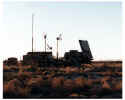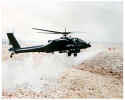1986
FY 86 HAWK marked its 30th year of service as the Army's oldest operational missile. During this span of time, HAWK had become one of the most widely deployed missiles in the Free World, used by the U.S. Army, USMC, and 20 friendly nations.
FY 86 REDEYE system reliability remained high, but sources for secondary items and repair parts for system support to the U.S. Army and FMS customers became a major issue.
FY 86 The last buy of M65 TOW missiles to complete fielding of the COBRA helicopter to ARNG was awarded to Hughes Aircraft.
FY 86 During the second quarter, MICOM terminated the TOW 2 WCL contracts with Hughes Aircraft for convenience to the government. The command took this action because of the uncertain delivery of two required very high speed integrated circuit (VHSIC) chips to be used in the missile receiver electronics unit.
1 January 86 The first Netherlands PATRIOT equipment was delivered.

1 January 86 The AMWS Project Office (Provisional) was redesignated the AAWS Project Office (Provisional). In addition to the AT-4, M72E4, and AAWS-M, the renamed office also assumed responsibility for the AAWS-H, a proposed replacement for the TOW weapon system.
7 January 86 MICOM Commander MG Peter Burbules presented Mary T. Cagle, then the Command Historian, with the first MICOM Distinctive Unit Insignia (DUI). The crest was gold in color and portrayed an upright missile between two gold flashes. The background was scarlet and blue. Engraved across the top and bottom of the emblem were the words, "Excellence in Missilery." The insignia's cloudlike, four-lobed shape and the missile symbolized MICOM's mission of missile research, development, production, fielding, and logistics support as well as its historic achievements in the American space program. The scarlet and blue colors symbolized Combat Arms and the Ordnance, Chemical, Engineering, and Transportation Corps. The flashes symbolized the support given by the Signal Corps. The new DUI became a part of the uniform of MICOM soldiers during a ceremony held on 10 January.
7 January 86 Fielding of C Battery, 4/27th FA Battalion of VII Corps, marked the completion of the first pure MLRS battalion to be fielded in USAREUR.
February 86 All of the 18 reportable systems that MICOM managed worldwide met or exceeded the DA readiness goal of 90 percent for the first time.
13 March 86 The Naval Air Systems Command granted approval for the full production of more than 11,000 HELLFIRE missiles for the AH-1J and AH-1W fleet.
18 March 86 The Secretary of the Army signed the first project manager's (PM's) charter for the Army TACMS Project Office.

18 March 86 OSD directed the STINGER Project Office to procure and deploy a HMMWV mounted version of the STINGER missile system as a replacement to the MANPADS configuration.
31 March 86 The U.S. ROLAND Project Office was terminated effective this date. Management responsibility for the remaining ROLAND tasks was transferred to MLC the following day. The ROLAND Systems Management Office (SMO) was established as a subordinate element of MLC for management of residual ROLAND efforts.
4 April 86 The United States and Sweden signed a memorandum of understanding for the development of a Swedish ground-launched HELLFIRE (GLH) to satisfy Sweden's coastal defense requirement.
10 April 86 The MICOM Commander approved the release of the HELLFIRE system to the U.S. Army APACHE. The system met the FUE date of 15 April 86 for FORSCOM with the fielding to the 3d Squadron, 6th Cavalry Brigade Air Combat.

22 April 86 DA named MICOM's RD&E Center the best of its 34 laboratories for the second time in 5 years. The organization received recognition for technical merit as well as for areas such as people programs and organizational accomplishments.
May 86 The first lower enlisted couple moved into family housing on Redstone Arsenal. The installation was one of three Army posts selected to try extending family housing eligibility to soldiers in grades E-3 and below. Redstone allocated 46 family housing units for lower enlisted in the 1100 area on Hof Circle and Crozier Drive.
May 86 The European Executive Agency awarded the MLRS European production contract to the European Production Group, Munich, Germany.
12 May 86 MG Thomas D. Reese assumed command of MICOM.

June 86 The official ribbon-cutting ceremony for the Life Cycle Software Engineering Center was held. The new structure, home for the Battlefield Automation Management Directorate, served as a place for designing and developing computer technology to meet the needs of new weapon systems.
21 July 86 Construction began on a hangar missile test facility located at the airfield. The new building provided space for the RD&E Center to test rotary wing aircraft with missile systems. It was completed in March 88.
29 August 86 The MICOM Commander requested the full release of the improved low visibility (ILV) autopilot and the minimum smoke motor modifications to the HELLFIRE missile for issue to the U.S. Navy/USMC. AMC formally approved the release on 3 October 86.
29 August 86 A new research, development, test and evaluation (RDTE) contract was awarded to Hughes Aircraft to complete the WCL guidance system for TOW.
September 86 Fielding of the TOW 2 to the U.S. Army Western Command (WESTCOM) was completed on schedule.
September 86 The Swiss Parliament approved a TOW 2 co-production program with an estimated value of over $500 million.
September 86 PATRIOT demonstrated a tactical ballistic missile (TBM) engagement.
September 86 PATRIOT's inherent ATM capability was demonstrated with an off-the-shelf standard production missile. Accomplished by ground equipment software changes only, PATRIOT intercepted a LANCE missile simulating an SS-21 and deflected it from its objective.
September 86 The first five production STINGER-POST missiles were delivered on schedule.
17 September 86 Three contractors-Boeing Aerospace, LTV, and General Dynamics-submitted proposals for candidate PMS systems.
30 September 86 The USMC SEA COBRA/HELLFIRE IOC was met with the deployment of the system to the 39th Marine Aircraft Group, Camp Pendleton, California.
1 October 86 The DA Field Office, Patrick Air Force Base, Florida, was closed. MICOM had maintained this office since 1967, and it had supported not only MICOM but other Army organizations by coordinating Army use of the Eastern Test Range.
27 October 86 Ground was broken on the southeastern part of Redstone Arsenal for a new 300-foot, $2.1 million tower to serve as the MICOM target seeker and measurement facility. The tower was expected to save money and be more reliable for measuring and developing seekers.
November 86 Technical and operational tests and evaluations of the three candidate PMS systems began during this month.
4 November 86 The FOG-M Project Office was established as a division in the RD&E Center's Systems Development Office.

December 86 A letter contract was awarded to LTV Aerospace and Defense Company (LTVAD) to provide initial support for the integration of the Sense and Destroy Armor (SADARM) submunitions into the MLRS. The MLRS SADARM was a derivative of the existing MLRS rocket. It was envisioned that the descending submunition, using a dual-mode millimeter wave (MMW) and infrared (IR) sensor, would search for a target and after detecting it, fire an explosively formed penetrator to impact the target from the top.
Redstone Arsenal Era:
Intro,
1980,
1981,
1982,
1983,
1984,
1985,
1986,
1987,
1988,
1989
